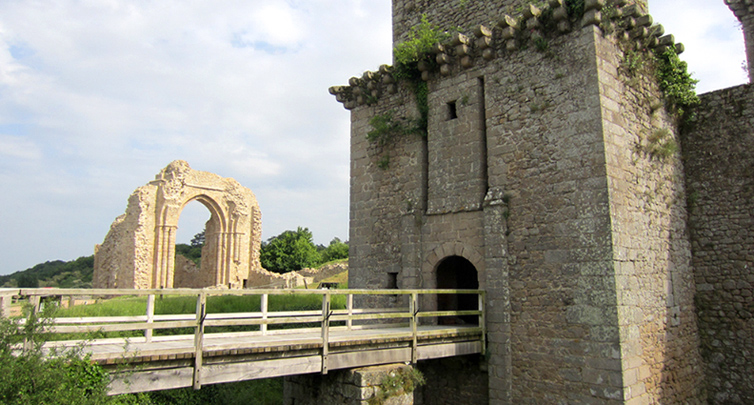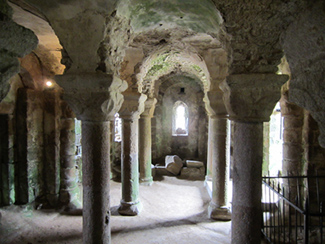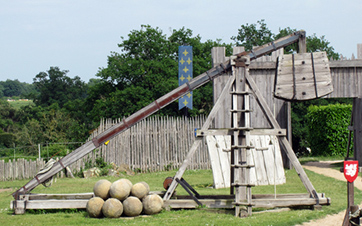Le Château de Tiffauges - France

Tiffauges Castle stands in the centre of a massif of granite rock extending from Mortagne-sur-Sèvre to Clisson in the Vendée region of France at the confluence of the rivers Sèvre Nantaise and Crume. Early settlers were quick to recognise the defensive capabilities of this site and it may be right here that the Teifales, barbarian warriors, recruited to defend the Roman Empire, settled around the 5th century. This would explain the origin of the town's name: Tiffauges.
In the medieval era, the powerful lords needed to protect places of key strategic importance such as Tiffauges in the heart of the Marches separating the very important regions of Poitou, Brittany and Anjou and so it is likely that at this time, the first stone fortification would have been built.
The 12th century was a time of growing prosperity and a market was created at Tiffauges. The first parts of the current castle: the donjon, the gate tower, curtain walls and chapel would have been built by the powerful Viscounts de Thouars at this time. The ring of walls which surround the main parts of the castle are of much later construction and basically this fortress resembles a cube with semi-cylindrical turrets strengthening the middle of each of the donjon's sides. A narrow high gateway blocked by a beam is the only means of accessing the donjon and this gateway opensonto the inside of the guardhouse on the first floor of the gate  tower commanding the entrance to the castle. The portcullis would have been controlled from here and trap doors inthe floor which were known as assommoirs were used to stop the enemy advance. All of this would have created a pretty formidable barrier to the main part of the castle. Not much remains today of the inside of the donjon except the outlines of fireplaces and a few openings reminding us of the lavish lifestyles of the Lords of this castle.
tower commanding the entrance to the castle. The portcullis would have been controlled from here and trap doors inthe floor which were known as assommoirs were used to stop the enemy advance. All of this would have created a pretty formidable barrier to the main part of the castle. Not much remains today of the inside of the donjon except the outlines of fireplaces and a few openings reminding us of the lavish lifestyles of the Lords of this castle.
Further in the castle's enclosure are the ruins of the chancel of a Romanesque chapel dedicated to St Vincent and beneath the chapel is a wonderful crypt which can still be entered today with its two rows of granite columns decorated with carved capitals. The crypt (right) is said to be haunted probably due to the castles' most infamous owner the sadistic murderer: Gilles de Rais who was ultimately tried and found guilty of countless murders.
Click photo right to enlarge
During the 13th century a series of hollow towers was added to the original ring of walls in the Romanesque style pierced with bowman’s loopholes allowing defenders to fire sideways at any attackers reaching the base of the castle walls. A lower defensive wall was also constructed encircling the castle towers and curtain walls affording defence of their base and allowing patrols to move around behind the palisade - this being a response to new techniques learned particularly during the Crusades. Until this time, the purpose of the siege had been to deprive a castle of supplies and communication but thereafter siege techniques were revolutionised by mechanically operated weapons for throwing stones for example the bricole, the couillard, and the trebuchet – employing the principles of the catapult and the balance. These weapons were of enormous destructive power. At Tiffauges Castle today one can see faithfully reconstructed examples of these weapons of the Middle Ages built by master craftsmen even with dramatic demonstrations of their use. (Below right: trebuchet at Tiffauges Castle - Click to enlarge)
 The Hundred years War created a need for further modifications to the castle for at this time this area was one of the major fields of combat with the English taking possession of Poitou in 1360 and the French retaking it in 1372. The area generally fell into lawlessness with much rape and pillage and murder by rogue bands of unpaid soldiers. All of this necessitated further strengthening of the castle and it is to the entrance to the castle, its most vulnerable point of attack that the most notable alterations were made. The gate tower was flanked by guard tower designed to house the guardroom and the donjon was much reinforced through the construction of an outer skin of ring of walls, itself protected on the inner courtyard side by the Châtelet, a square sided tower. A drawbridge spanning a ditch filled with water provided access. Gun ports appeared throughout the fortress allowing the combined use of crossbows and breech loading canons. Also around the 14th to 15th centuries, a powerful dyke was constructed returning a large body of water serving to protect the western flank of the castle and although the middle section was later demolished, the earthwork with dressed stone remains impressive. In fact it was on the side of the castle overlooking the dyke where the river Crume becomes narrower that artillery fire posed the most threat and it is here that Vidame's Tower was constructed. The tower rises to around 60 feet with a smooth outer surface without any gun ports which might weaken it. One can still visit the vaulted chambers inside the tower.
The Hundred years War created a need for further modifications to the castle for at this time this area was one of the major fields of combat with the English taking possession of Poitou in 1360 and the French retaking it in 1372. The area generally fell into lawlessness with much rape and pillage and murder by rogue bands of unpaid soldiers. All of this necessitated further strengthening of the castle and it is to the entrance to the castle, its most vulnerable point of attack that the most notable alterations were made. The gate tower was flanked by guard tower designed to house the guardroom and the donjon was much reinforced through the construction of an outer skin of ring of walls, itself protected on the inner courtyard side by the Châtelet, a square sided tower. A drawbridge spanning a ditch filled with water provided access. Gun ports appeared throughout the fortress allowing the combined use of crossbows and breech loading canons. Also around the 14th to 15th centuries, a powerful dyke was constructed returning a large body of water serving to protect the western flank of the castle and although the middle section was later demolished, the earthwork with dressed stone remains impressive. In fact it was on the side of the castle overlooking the dyke where the river Crume becomes narrower that artillery fire posed the most threat and it is here that Vidame's Tower was constructed. The tower rises to around 60 feet with a smooth outer surface without any gun ports which might weaken it. One can still visit the vaulted chambers inside the tower.
The castle was caught up In the Wars of Religion and burnt down in 1569 and following this, the castle's fortifications were demolished in 1626 due to a royal decree. The castle passed between various parties until it gradually fell into ruin.
Tiffauges Castle did serve for a while as a base of operations during the Wars of the Vendée and in September 1793 one might have seen the vendéens in mortal combat with the Republican forces who had been sent to destroy them on a nearby plateau. By the following year following the defeat of the armies of the Vendée, Cordelier’s Infernal Columns descended upon Tiffauges where hundreds of men and women were massacred. Today a cross stands at a place between the town and the castle as a memorial to these crimes!
Back to list of French Medieval Castles


